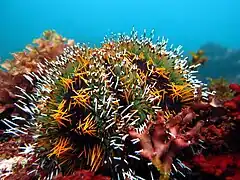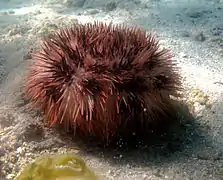| Toxopneustidae | |
|---|---|
 | |
| Tripneustes gratilla | |
| Scientific classification | |
| Domain: | Eukaryota |
| Kingdom: | Animalia |
| Phylum: | Echinodermata |
| Class: | Echinoidea |
| Order: | Camarodonta |
| Infraorder: | Echinidea |
| Family: | Toxopneustidae Troschel, 1872 [1] |
Toxopneustidae is a family of globular sea urchins in the class Echinoidea.
Characteristics
All Camarodonts have imperforate tubercles and compound ambulacral plates. In addition, the Toxopneustids are characterised by the peristome, or opening through the test, having a sharp margin with the buccal notches being prominent. The tubercles lack the crenulations or ring of cog-like structures that articulate with the spines in certain other families. The Aristotle's lantern, or jaw apparatus, has the keeled teeth and the epiphyses united above the foramen magnum, the V-shaped gap between the hemipyramids that support the lantern's tooth.[2]
Genera
- Goniopneustes Duncan, 1889
- Gymnechinus Mortensen, 1903b
- Lytechinus A. Agassiz, 1863
- Nudechinus H.L. Clark, 1912
- Oligophyma Pomel, 1869
- Pseudoboletia Troschel, 1869
- Schizechinus Pomel, 1869
- Scoliechinus Arnold & H.L. Clark, 1927
- Sphaerechinus Desor, 1856
- Toxopneustes L. Agassiz, 1841b
- Tripneustes L. Agassiz, 1841b [1]
References
- 1 2 Toxopneustidae World Register of Marine Species. Retrieved 2011-08-27.
- ↑ The Echinoid Directory The Natural History Museum. Retrieved 2011-08-27.
This article is issued from Wikipedia. The text is licensed under Creative Commons - Attribution - Sharealike. Additional terms may apply for the media files.


.jpg.webp)
_edit.jpg.webp)
